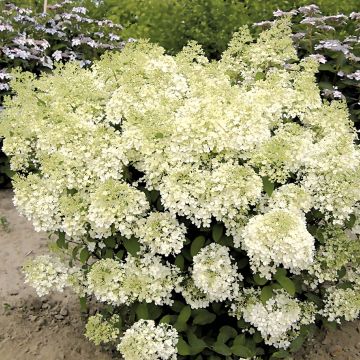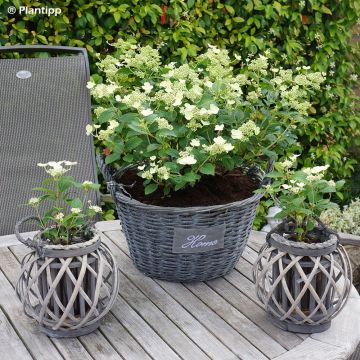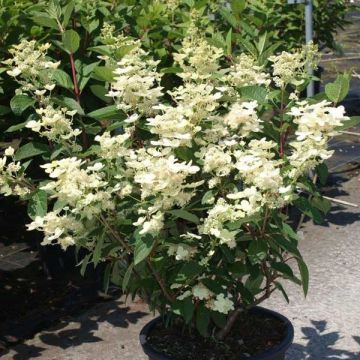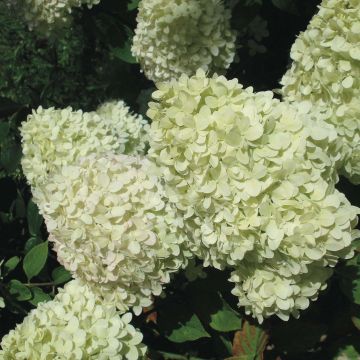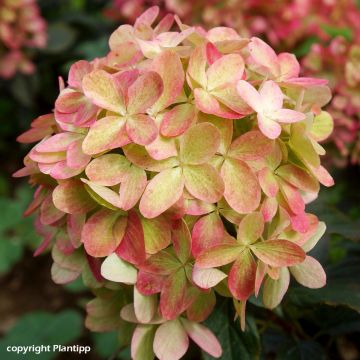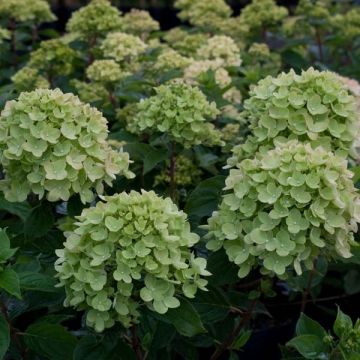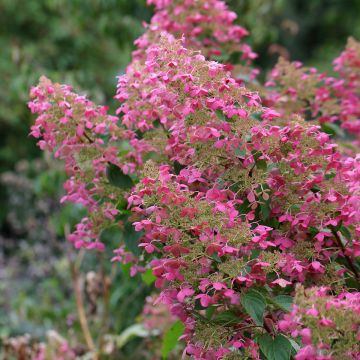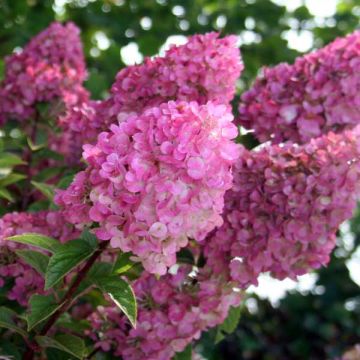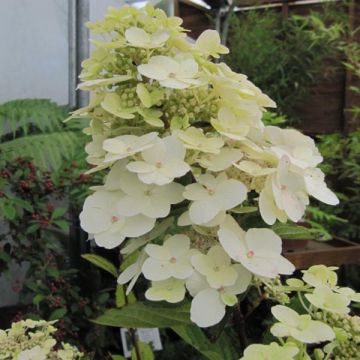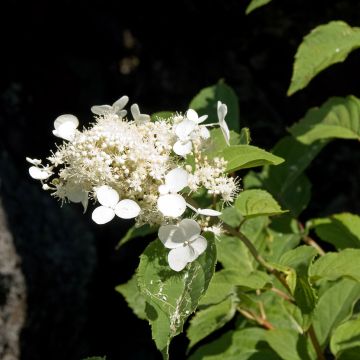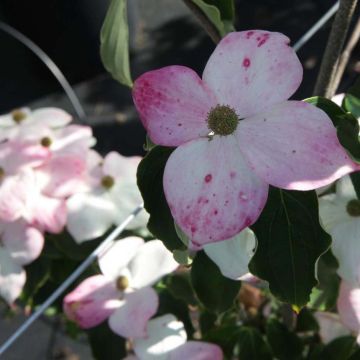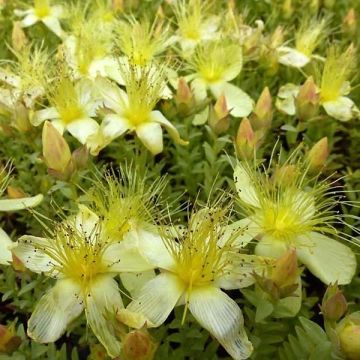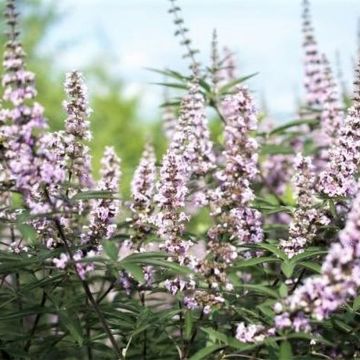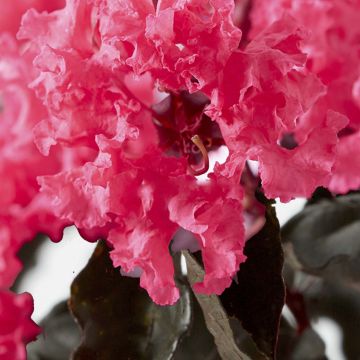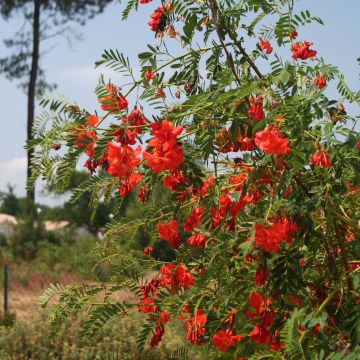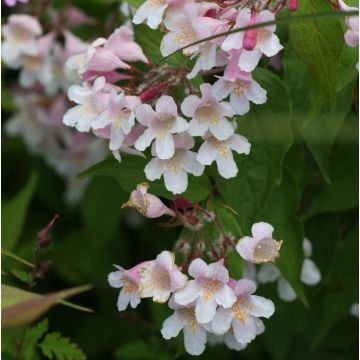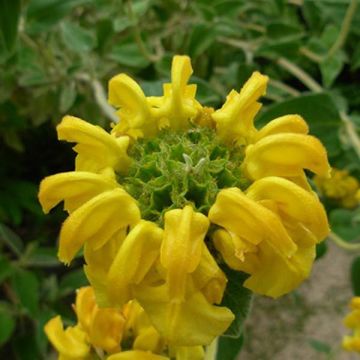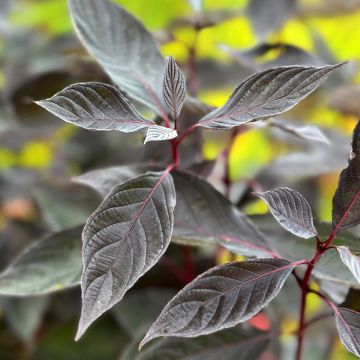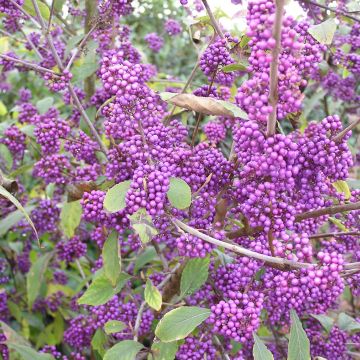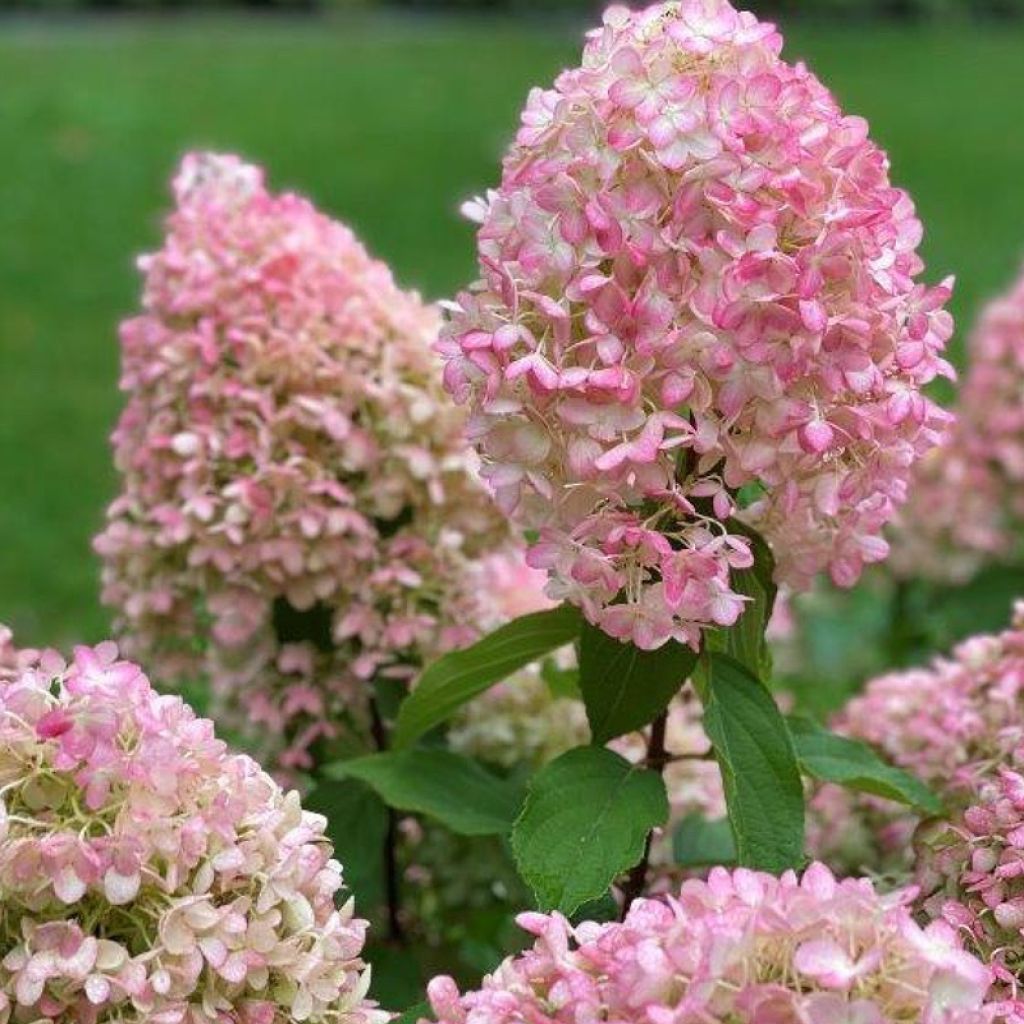

Hydrangea paniculata Pinkachu
Hydrangea paniculata Pinkachu
Hydrangea paniculata Pinkachu®
Paniculate Hydrangea, Panicled Hydrangea, Panicle Hydrangea
This item cannot be shipped to the selected country
Delivery charge from €5.90
More information
Schedule delivery date,
and select date in basket
This plant carries a 24 months recovery warranty
More information
We guarantee the quality of our plants for a full growing cycle, and will replace at our expense any plant that fails to recover under normal climatic and planting conditions.
From €5.90 for pickup delivery and €6.90 for home delivery
Express home delivery from €8.90.

Does this plant fit my garden?
Set up your Plantfit profile →
Description
Hydrangea paniculata ‘Pinkachu’ is a recent American creation with a remarkably compact habit and early flowering. Its beautiful inflorescences in plump, conical panicles begin white, tinting to a deep pink and then to red with cooler summer nights. They are supported on particularly sturdy stems, unaffected by the weight of rain-soaked flowers. Its foliage is a deep green. Very hardy, and tolerant of sun and slightly calcareous soils, this shrub is very well suited to pot cultivation.
Hydrangea paniculata ‘Pinkachu’ is a recent cultivar, developed at the American Spring Meadow nursery in 2015. It is a descendant of the ‘Little Lamb’ cultivar. The Hydrangea paniculata species is native to the temperate eastern regions of China and Japan. ‘Pinkachu’ has excellent hardiness (down to -30 °C). It adapts to sun and relative drought, while showing more tolerance towards calcareous soils than the traditional Hydrangea macrophylla. It forms a compact bush with an erect and ramified habit, reaching about 60 cm (23.6 in) in height by 80 cm (31.5 in) in spread, with rapid growth. Its flowering generally begins in early July and continues until early autumn. Initially greenish-white, its slender panicles, about 12 cm (4.7 in) long, composed of sterile and fertile florets, gradually turn pink, then completely dark pink or red in early autumn. Its sturdy branches easily support the weight of the flowers. They are covered in beautiful dark green, ovate, deciduous foliage. This exceptional variety requires no pruning.
Planted in any good garden soil, without too much lime however, Hydrangea paniculata ‘Pinkachu’ displays rapid growth. It is a very hardy variety, which can be planted in a low hedge or in a mixed bed with other hydrangeas and perpetual roses to play with contrasts and shapes. Its small stature allows it to be incorporated into a small garden and to be grown without difficulty in a large pot on the terrace where it will live for many years with some additions of fertiliser and regular watering.
Report an error about the product description
Hydrangea paniculata Pinkachu in pictures
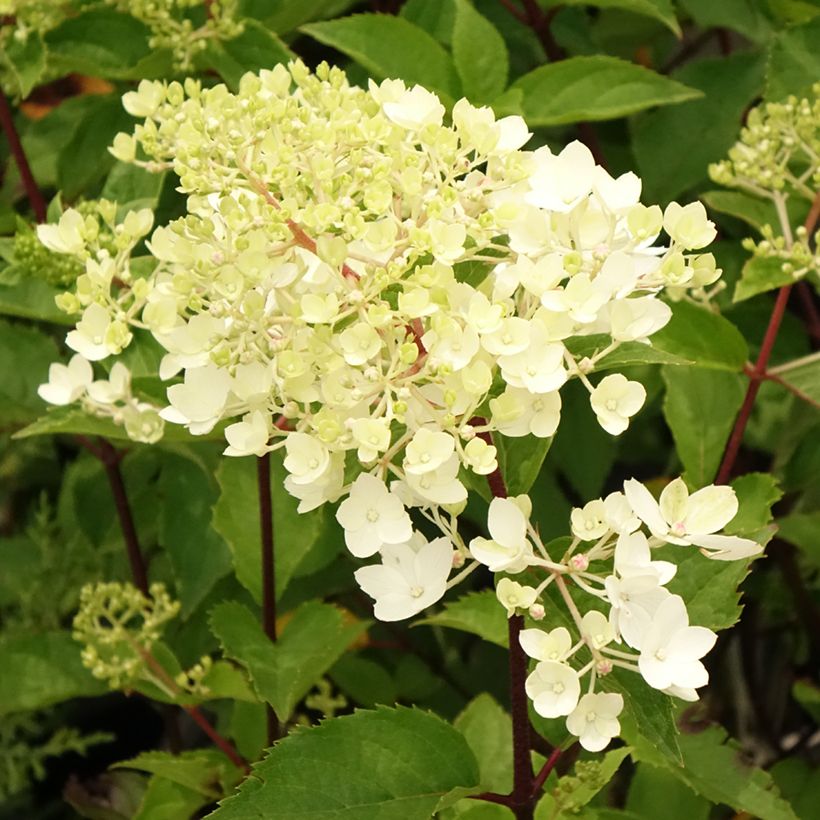

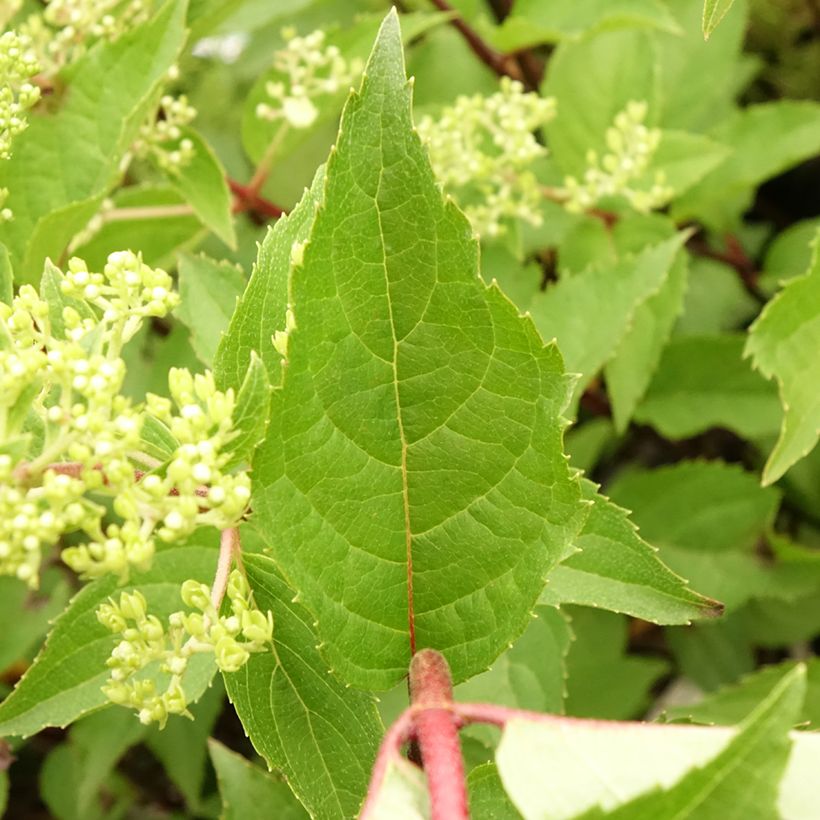

Plant habit
Flowering
Foliage
Botanical data
Hydrangea
paniculata
Pinkachu®
Hydrangeaceae
Paniculate Hydrangea, Panicled Hydrangea, Panicle Hydrangea
Cultivar or hybrid
Other Hydrangea Paniculata
Planting and care
Hydrangea paniculata Pinkachu is not too demanding about the nature of the soil, as long as it is not too heavy, and not too chalky. It requires a sunny but non-scorching, or semi-shaded exposure. When planting, install it in deeply worked soil. A good base fertiliser (horn or dried blood) will aid the recovery of your young plant and feed it without risk of burning. If your soil has a tendency towards dryness, mix our STOCKOSORB® water retainer with the soil when filling the planting hole and provide a surface watering basin.
At the end of summer, we advise you not to cut the dry panicles that will protect the terminal shoots of the branches in winter; you should cut all the dry flowers at the end of February or on the first summer days. The plant's spring vegetation appears rather late.
Hydrangea Paniculata: these shrubby hydrangeas with elongated inflorescences are resistant to drought and easily settle even in non-acidic soil. They bloom generously from June until the frosts. Planted in the sun, their inflorescences change colour in the autumn.
Planting period
Intended location
Care
-
, onOrder confirmed
Reply from on Promesse de fleurs
Summer-flowering shrubs
Haven't found what you were looking for?
Hardiness is the lowest winter temperature a plant can endure without suffering serious damage or even dying. However, hardiness is affected by location (a sheltered area, such as a patio), protection (winter cover) and soil type (hardiness is improved by well-drained soil).

Photo Sharing Terms & Conditions
In order to encourage gardeners to interact and share their experiences, Promesse de fleurs offers various media enabling content to be uploaded onto its Site - in particular via the ‘Photo sharing’ module.
The User agrees to refrain from:
- Posting any content that is illegal, prejudicial, insulting, racist, inciteful to hatred, revisionist, contrary to public decency, that infringes on privacy or on the privacy rights of third parties, in particular the publicity rights of persons and goods, intellectual property rights, or the right to privacy.
- Submitting content on behalf of a third party;
- Impersonate the identity of a third party and/or publish any personal information about a third party;
In general, the User undertakes to refrain from any unethical behaviour.
All Content (in particular text, comments, files, images, photos, videos, creative works, etc.), which may be subject to property or intellectual property rights, image or other private rights, shall remain the property of the User, subject to the limited rights granted by the terms of the licence granted by Promesse de fleurs as stated below. Users are at liberty to publish or not to publish such Content on the Site, notably via the ‘Photo Sharing’ facility, and accept that this Content shall be made public and freely accessible, notably on the Internet.
Users further acknowledge, undertake to have ,and guarantee that they hold all necessary rights and permissions to publish such material on the Site, in particular with regard to the legislation in force pertaining to any privacy, property, intellectual property, image, or contractual rights, or rights of any other nature. By publishing such Content on the Site, Users acknowledge accepting full liability as publishers of the Content within the meaning of the law, and grant Promesse de fleurs, free of charge, an inclusive, worldwide licence for the said Content for the entire duration of its publication, including all reproduction, representation, up/downloading, displaying, performing, transmission, and storage rights.
Users also grant permission for their name to be linked to the Content and accept that this link may not always be made available.
By engaging in posting material, Users consent to their Content becoming automatically accessible on the Internet, in particular on other sites and/or blogs and/or web pages of the Promesse de fleurs site, including in particular social pages and the Promesse de fleurs catalogue.
Users may secure the removal of entrusted content free of charge by issuing a simple request via our contact form.
The flowering period indicated on our website applies to countries and regions located in USDA zone 8 (France, the United Kingdom, Ireland, the Netherlands, etc.)
It will vary according to where you live:
- In zones 9 to 10 (Italy, Spain, Greece, etc.), flowering will occur about 2 to 4 weeks earlier.
- In zones 6 to 7 (Germany, Poland, Slovenia, and lower mountainous regions), flowering will be delayed by 2 to 3 weeks.
- In zone 5 (Central Europe, Scandinavia), blooming will be delayed by 3 to 5 weeks.
In temperate climates, pruning of spring-flowering shrubs (forsythia, spireas, etc.) should be done just after flowering.
Pruning of summer-flowering shrubs (Indian Lilac, Perovskia, etc.) can be done in winter or spring.
In cold regions as well as with frost-sensitive plants, avoid pruning too early when severe frosts may still occur.
The planting period indicated on our website applies to countries and regions located in USDA zone 8 (France, United Kingdom, Ireland, Netherlands).
It will vary according to where you live:
- In Mediterranean zones (Marseille, Madrid, Milan, etc.), autumn and winter are the best planting periods.
- In continental zones (Strasbourg, Munich, Vienna, etc.), delay planting by 2 to 3 weeks in spring and bring it forward by 2 to 4 weeks in autumn.
- In mountainous regions (the Alps, Pyrenees, Carpathians, etc.), it is best to plant in late spring (May-June) or late summer (August-September).
The harvesting period indicated on our website applies to countries and regions in USDA zone 8 (France, England, Ireland, the Netherlands).
In colder areas (Scandinavia, Poland, Austria...) fruit and vegetable harvests are likely to be delayed by 3-4 weeks.
In warmer areas (Italy, Spain, Greece, etc.), harvesting will probably take place earlier, depending on weather conditions.
The sowing periods indicated on our website apply to countries and regions within USDA Zone 8 (France, UK, Ireland, Netherlands).
In colder areas (Scandinavia, Poland, Austria...), delay any outdoor sowing by 3-4 weeks, or sow under glass.
In warmer climes (Italy, Spain, Greece, etc.), bring outdoor sowing forward by a few weeks.

































